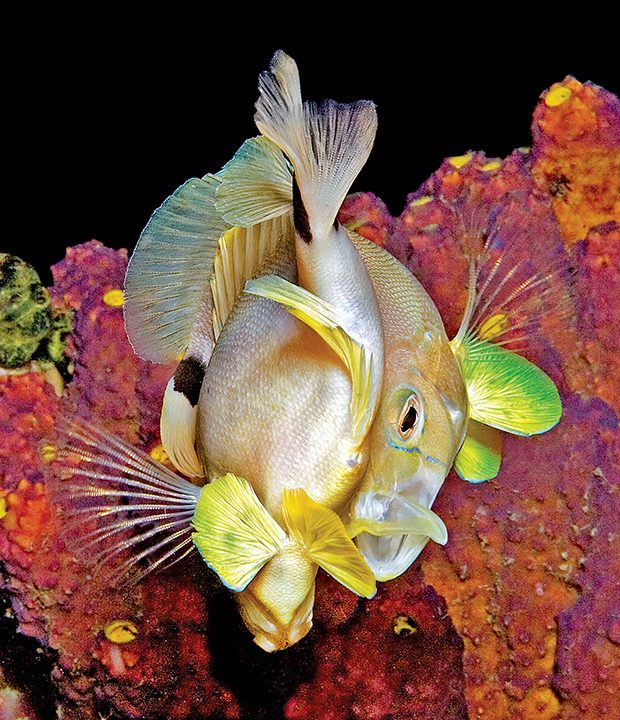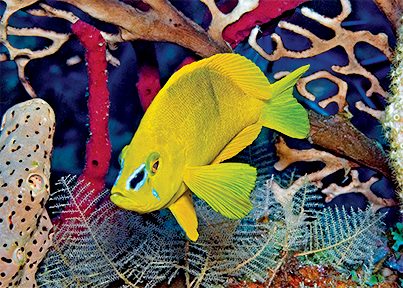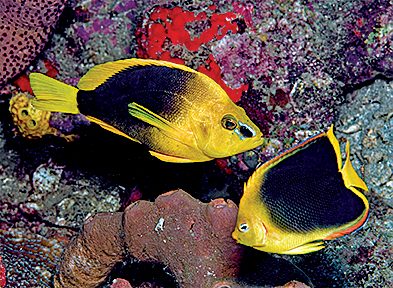To be or not to be a species
SINCE THE LATE 1800S, debate among marine taxonomists has swirled around the species status of the stately little Caribbean sea basses in genus Hypoplectrus, commonly known as hamlets. At the heart of the controversy is the essence of taxonomy: What defines a species?
The most common interpretation of species relates to individuals capable of mating with one another to produce fertile offspring. The hamlet intrigue revolves around the group’s similar breeding habits and almost complete lack of anatomical differences. Yet, for an unexplained reason, hamlets across the Caribbean display a variety of distinct color patterns.

Adding even more spice to hamlet soup is the smorgasbord of variations from a relatively high amount of interbreeding between color morphs, which gives rise to hybrids, intermediate in color and markings from their parents.
Typically, the offspring of different species in the same genus are sterile, but hamlet hybrids are fertile — an anomaly some researchers have used as evidence against granting separate species status to members of the genus. Over the years they have described the hamlet flock as varieties, types, color morphs, morphotypes morphospecies, and subspecies.
Using evidence available from aquarium breeding and the discovery of low genetic differences among species from the same geographical regions, however, today’s taxonomists uneasily lean toward granting species status to at least 18 distinct and regularly occurring color morphs.
Of more interest to the typical underwater naturalists is the hamlets’ impassioned courtship and spawning behaviors that take place each evening during the fading glow of twilight. Throughout the day the palm-sized loners poke around for crabs, shrimp, and recently settled larval fishes inside the craggy confines of their limited home ranges. As the sun sets, they slip out of their comfortable surroundings and wind their way through hostile terrain for nightly trysts with established partners at traditional spawning sites.
Like several noted reef fish families, hamlets are simultaneous hermaphrodites, which means they are both male and female at the same time. Instead of constantly jockeying for position, the hamlets take turns releasing eggs and sperm multiple times with longstanding partners. The egalitarian reproductive strategy is rare, occurring in only 40 of 34,000 fish species.


As soon as a pair of starry-eyed hamlets rendezvous, the reef’s most accessible, predictable, and entertaining reproductive spectacle begins. For up to an hour before the first spawn, pairs playfully chase and feed near the bottom while watching for predators and rivals keen on breaking up the evening’s lovefest.
As the courtship comes to an end, one of the pair assumes the female role. Acting the seducer, she strikes a taut snout-up pose with fins flared and head snapping, as the interim male, whose color is distinctly blanched, mills about the bottom. The hamlets rise separately into the water column, customarily above a coral mound or gorgonian bush where the displayer presents herself.
In a blink the fish clasp, like encircling hands. The acting male — with his head down, belly puckered, fins spread, and mouth opened — is enveloped by the arching body of his mate. After a few seconds the fish pop apart, leaving behind an inconspicuous cloud of gametes. The pair alternately play out the clasps, ranging from two to 10 or more, until the last light fades.
An equal number of egg releases between partners is sacrosanct. From dozens of spawning events we’ve observed, the clasp count ended on an odd number only twice. Both incidents incited nipping chases by the wronged party.
What drives the diversification of hamlets? Opinions vary among researchers, but the general consensus is that genus Hypoplectrus may not have evolved until after the closing of the Isthmus of Panama approximately 2.8 million years ago. The date might seem ancient, but on an evolutionary time scale hamlets are the new kids on the block and still evolving.
And then there is the suggestion that the rise and fall of sea levels segregated the color morphs. Further muddling the matter is the hypothesis that the mimicking of nonpredatory fishes drives the hamlets’ various color patterns.
And what exactly is a species? This classic question also remains agonizingly unanswered even after the greatest minds in biology have pondered it since the beginning of evolutionary science.
Following the discovery of astounding differences in every genus of barnacles he studied, Charles Darwin wrote from his study at Down House: “After describing a set of forms as distinct species, tearing up my MS., and making them one species, tearing that up and making them separate, and then making them one again, I have gnashed my teeth, cursed species, and asked what sin I had committed to be so punished.” AD
© Alert Diver — Q3 2023